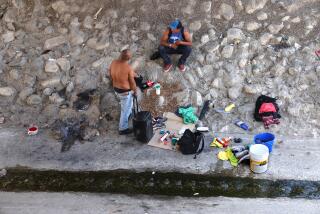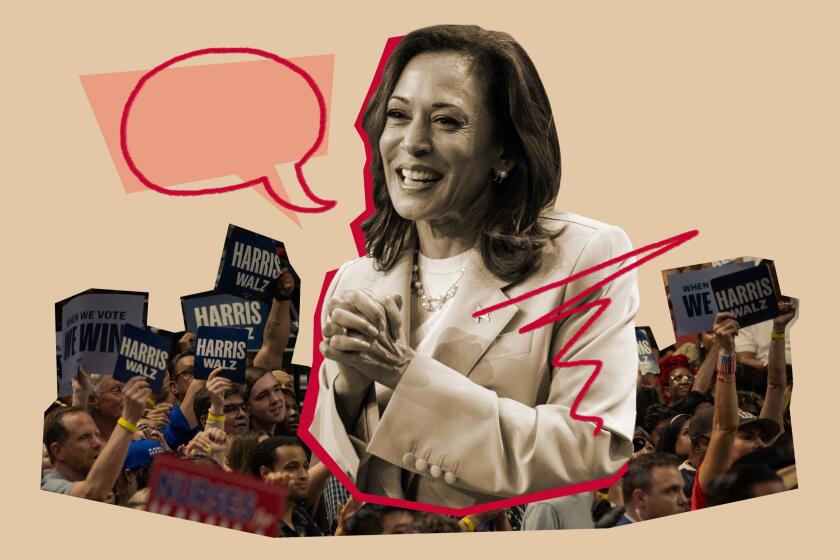Jobs Are Primary Concern in State
For unemployed software engineer Dean McCoy, there is only one issue worth considering in Tuesday’s California presidential primary: the economy.
Laid off two years ago, McCoy has burned through his savings, lost his home, filed for bankruptcy and moved back in with his 84-year-old mother in Reseda. How to find good-paying employment again “is my biggest worry,” said McCoy, 53. “It keeps me up at night.”
Multiply McCoy’s worries by tens of thousands of other Californians, and it’s no surprise that the economy and its ability to create jobs is by far the No. 1 thing on the minds of the state’s voters, according to a recent Los Angeles Times Poll and other surveys. That explains the heavy emphasis Sens. John F. Kerry of Massachusetts and John Edwards of North Carolina have placed on the worries of people like McCoy as they campaign from California to New York ahead of the 10-state Super Tuesday balloting.
Californians have good reason for concern about the economy. In the technology industry crash, the state lost thousands of high-paying jobs that won’t easily be regained. Its manufacturing sector, which has provided employment to waves of low-skilled immigrants, is under siege from foreign competition. Pockets of the state’s tourism industry are still suffering effects from the Sept. 11 terrorist attacks. Booming housing prices, skyrocketing workers’ compensation costs and other escalating costs have employers of all stripes looking elsewhere to expand their companies.
Consequently, California’s recovery from the 2001 recession is still sluggish, with the state lagging behind the nation on a variety of fronts. Unemployment is higher. Exports are weaker. Income growth is punier. And the state suffers from a budget shortfall so vast that voters are being asked to allow the state to borrow billions of dollars just to pay its bills.
Still, the Golden State’s recovery appears to be gaining momentum. Businesses are beginning to buy more computers and other high-tech goods. California’s growing population is fueling demand for services in such sectors as education, healthcare and retail. The recovery in the rest of the U.S. and fast growth in China are driving demand for California products including movies, music, cotton and scrap metal.
Thus California, which shed about 56,000 nonfarm jobs last year, has picked up its hiring pace in recent months. It now appears that the Golden State’s employment growth rate is on track with the country as a whole. Since nonfarm employment fell to its lowest level in July, California’s economy has added an average of 5,500 jobs a month through December. And in January, employers increased payrolls by 22,200.
“I’m encouraged by the trend we have from July to January,” said Howard Roth, chief economist at the state Finance Department.
Likewise, economists from UCLA, among the most accurate and pessimistic during the downturn, expect that after three years of falling nonfarm employment, California will outpace the nation this year and next in job growth. In addition, U.S. home prices are on a tear, particularly in California, where refinancing by homeowners has tapped billions of dollars in equity and fueled consumer spending.
And the state’s economy is much better off than it was coming out of the deep recession of the early 1990s. At that time, unemployment was hovering near 10%, compared with 6.5% to 7% in the last couple of years. Silicon Valley is still losing jobs, yet the San Joaquin Valley and Inland Empire are adding them at a respectable clip, thanks in part to more affordable housing that is attracting new residents and businesses to serve them.
“It’s easy to forget that other parts of the state are doing relatively well,” said Mark Schniepp, principal of the California Economic Forecast, a Santa Barbara-based economic consulting firm.
So what’s eating California voters? Although attitudes about the economy have improved somewhat since August, when 71% of those surveyed in The Times Poll had said the economy was doing badly, 56% still feel that way.
“This doesn’t look like a group of people who feel a recovery is underway,” said Mark Baldassare, director of research at the Public Policy Institute of California in San Francisco. The nonpartisan research group recently conducted a poll in which Californians pointed to the economy, jobs and unemployment as their principal concerns, with more than half of those surveyed saying the state was moving in the wrong direction.
Some believe that many voters’ lingering ill feelings about the economy aren’t so much a reflection of how bad things really are, but rather of fears brought on by continuing globalization and the migration of U.S. jobs offshore, which have become important themes in the presidential race.
More than half of the 1,936 people surveyed in the recent Times Poll said U.S. trade with foreign countries takes more jobs from California than it creates. As the nation’s most trade-dependent state, California’s merchandise exports account for about 7% of its economic activity and provide jobs for more than a million workers.
But that sector has been slammed in recent years, with most of the pain centered in the state’s vital technology industry. Its exports of computers and electronic products have fallen by nearly two-thirds from the peak in 2000.
Technology employment nationwide has tumbled by nearly 775,000 from a high of 6.5 million jobs in 2001. More than one-fifth of those losses came from California, according to the American Electronics Assn.
Although the technology industry’s sales and earnings are improving, the gains have yet to translate into the hiring of American workers. Many blame this jobless tech recovery on aggressive outsourcing overseas by U.S. firms.
Unemployed systems administrator Daniel Curry said he recently received an inquiry from an employer looking for someone with his skills. The hitch was that the Fremont resident would have to relocate -- to Bangalore, India. With his bank account empty and his credit worn thin, Curry said he briefly considered taking the $4.85-an-hour position, if only to get a foot in the door of what some have dubbed the Silicon Valley of Asia.
“I realized it was too insane,” said Curry, 36, who turned down the job despite being unemployed since the fall. “But it was a wake-up call to me on how desperate I am for work.”
He’s not alone. Although California’s jobless rate has fallen steadily, to 6.1% last month from 6.8% in January 2003, more than 1 million Californians remain unemployed. Nearly 1 in 4 of them has been out of work longer than six months.
Economists are scrambling to develop solid data on the true size of the outsourcing trend and its effect on the U.S. labor market. A 2001 study done for a congressional panel estimated that at least 760,000 U.S. production jobs had migrated to China since 1992. Research and consulting firm Economy.com in October estimated that nearly 1 million U.S. jobs had been lost to so-called offshoring since early 2001, with 1 in 6 of those in information technology, financial services or business and professional services -- the bedrock of the “new economy.” Forrester Research Inc. predicts 3.3 million service and professional jobs will flee the country by 2015, and researchers at UC Berkeley figure that at least 14 million U.S. service jobs are vulnerable.
No figures are available that measure offshoring exclusively from California, but analysts say its high concentration of technology and manufacturing jobs have put it squarely in the trend’s crosshairs.
Still, many economists contend that, on the whole, globalization and foreign trade have been a net positive for the state and nation.
Mark Zandi, chief economist at Economy.com, says foreign trade gives firms greater choice and lower prices on everything from the computers and cellphones used in their businesses to the apparel and toys they sell. Lower import prices also have helped tamp down inflation, he says. And foreign investors have been aggressive buyers of U.S. Treasury and mortgage-backed bonds, contributing to lower interest rates that have been fueling the housing market and building industry.
Nonetheless, “people sense huge and rapid structural change in the global economy, and that’s affecting people’s view of their own job security,” said Keitaro Matsuda, senior economist at Union Bank of California.
Even for Californians whose jobs are fairly secure, concern about the economy may stem in part from feeble growth in their incomes.
Since the downturn that began in early 2001, personal income growth in California has lagged all other Western states except Colorado. Although the pace of U.S. income growth has picked up in recent quarters, California remains in the bottom half of the country, largely because the state is creating few new jobs.
The state Department of Finance’s Roth estimated that total personal income -- which includes wages, stock options and rental income -- increased 3.1% last year. He and most other forecasters expect the rate of income growth statewide to reach the 5% range this year, but that would still be considerably lower than in other periods of economic expansion.
Sluggish job and income growth could exacerbate California’s already sizable budget woes.
January marked the second straight month that tax receipts had come in below forecast, partly because personal income taxes -- the largest source of revenue -- aren’t climbing as fast as anticipated in a weak labor market.
What’s more, Roth noted, much of the hiring is in lower-paying sectors such as retail and tourism. Meanwhile, the state is likely to continue to lose jobs in higher-paying government and manufacturing industries.
Indeed, California has shed more than 350,000 factory jobs, or nearly 19% of its manufacturing employment base, in the last three years. That has voters like Bill Bloomer deeply troubled about the state’s economic future.
At first blush, the owner of National Metal Stampings Inc. in Lancaster would seem to have little to complain about. Business is so brisk at Bloomer’s firm, which employs 75 workers making automotive, medical and aerospace parts, that his order book is filled for weeks to come. But Bloomer said that’s largely because so many of his domestic competitors have gone under, rather than a strong signal that the U.S. factory segment is rebounding.
Add skyrocketing costs for workers’ compensation insurance, raw materials and other business expenses, and Bloomer said firms like his are an endangered breed in California. A staunch Republican, Bloomer has few kind words for the state’s Democratic-controlled Legislature, which has passed a flurry of perceived anti-business legislation in recent years.
Still, he saved his harshest criticism for the Bush administration, whose trade policies, he contended, were eroding the nation’s manufacturing base and threatening the country’s long-term standard of living. So fed up is Bloomer that he said he declined to vote for Bush in the primary, writing in Edwards’ name on his absentee ballot.
“I’m just a blue-collar guy who learned to run a business,” Bloomer said. “From where I’m standing, none of this looks good to me.”
*
(BEGIN TEXT OF INFOBOX)
California profile
California and nine other states hold Democratic presidential primaries or caucuses Tuesday, with a prize of 1,151 delegates up for grabs -- close to one-third of all those at stake this year. As of March 3, nearly 60% of the 2,162 delegates needed to win the party’s nomination will have been chosen.
State profile
*
Population
Statewide: 33.9 million
Urban residents: 94.5%
Residents 65 and older: 10.6%
Median household income: $47,493
Families below poverty line: 10.6%
Families with preschool children below poverty line: 19%
*
Party affiliation
Registered Republicans: 35.2%
Registered Democrats: 44.4%
Independents/minor parties: 20.4%
*
Ethnicity
White 46.7%
Latino 32.4%
Asian 10.9%
Black 6.7%
Native American 1%
Other 2.3%
*
Occupation
Management/professional: 36%
Sales/office: 26.8%
Production/transportation of goods: 12.7%
Service: 14.8%
Construction: 8.4%
Farming, fishing and forestry: 1.3%
*
Top exports
Circuits, computers and parts, airplane parts
*
California’s pledged delegates
Number of pledged delegates in each congressional district
District 1: 5
District 2: 4
District 3: 4
District 4: 4
District 5: 5
+ District 6: 6
+ District 7: 5
+ District 8: 7
+ District 9: 6
+ District 10: 5
District 11: 4
+ District 12: 6
+ District 13: 5
+ District 14: 5
+ District 15: 5
+ District 16: 5
District 17: 5
District 18: 4
District 19: 4
District 20: 4
District 21: 4
District 22: 4
District 23: 5
District 24: 4
District 25: 4
District 26: 4
++ District 27: 5
++ District 28: 5
++ District 29: 6
District 30: 6
++ District 31: 4
++ District 32: 4
++ District 33: 5
++ District 34: 4
++ District 35: 5
++ District 36: 5
++ District 37: 5
++ District 38: 4
++ District 39: 4
++ District 40: 4
District 41: 4
++ District 42: 4
++ District 43: 4
++ District 44: 4
District 45: 4
++ District 46: 5
++ District 47: 3
++ District 48: 4
District 49: 4
District 50: 4
District 51: 4
District 52: 4
District 53: 5
+ San Francisco-area districts
++ Los Angeles-area districts
*
Who the delegates are
California’s 370 pledged delegates are divided three ways:
241 - The district level: Three to seven delegates are allotted to each congressional district in the state based on Democratic turnout in previous elections there. District-level delegates are distributed based on primary results in that district.
81 - At-large delegates: These are simply selected registered Democrats, allotted according to statewide primary results.
48 - Party leaders and elected officials: These state officials also back candidates based on statewide primary results.
California also has 70 ‘super-delegates’: These are elected officials who are not required to commit to a given candidate and can change allegiance at any time. They bring the total state delegation to 440.
*
Democratic presidential primary history
1968
Robert Kennedy: 46.3%
Eugene McCarthy: 41.8%
Other: 11.9%
1972
George McGovern: 43.5%
Hubert Humphrey: 38.6%
George Wallace: 7.5%
Shirley Chisholm: 4.4%
Ed Muskie: 2.0%
Eugene McCarthy: 1.0%
Henry Jackson: 0.8%
Other: 2.2%
1976
Jerry Brown: 59.0%
Jimmy Carter: 20.4%
Frank Church: 7.3%
Morris Udall: 5.0%
George Wallace: 3.0%
Henry Jackson: 1.1%
Ellen McCormack: 0.9%
Fred Harris: 0.5%
Birch Bayh: 0.4%
Other: 2.4%
1980
Edward M. Kennedy: 44.8%
Jimmy Carter: 37.6%
Jerry Brown: 4.0%
Lyndon LaRouche: 2.1%
Other: 11.5%
1984
Gary Hart: 38.9%
Walter Mondale: 35.3%
Jesse Jackson: 18.4%
John Glenn: 3.3%
George McGovern: 2.4%
Other: 1.8%
1988
Michael Dukakis: 60.9%
Jesse Jackson: 35.1%
Al Gore: 1.8%
Paul Simon: 1.4%
Other: 0.8%
1992
Bill Clinton: 47.5%
Jerry Brown: 40.2%
Paul Tsongas: 7.4%
Bob Kerrey: 1.2%
Other: 3.8%
1996
Bill Clinton: 92.8%
Lyndon LaRouche: 6.9%
Other: 0.3%
2000
Al Gore: 81.2%
Bill Bradley: 18.2%
Lyndon LaRouche: 0.6%
*
Sources: U.S. Census Bureau and Almanac of American Politics, Federal Election Commission, Congressional Quarterly -- Graphics reporting by Times staff researcher Susannah Rosenblatt
More to Read
Get the L.A. Times Politics newsletter
Deeply reported insights into legislation, politics and policy from Sacramento, Washington and beyond. In your inbox three times per week.
You may occasionally receive promotional content from the Los Angeles Times.











